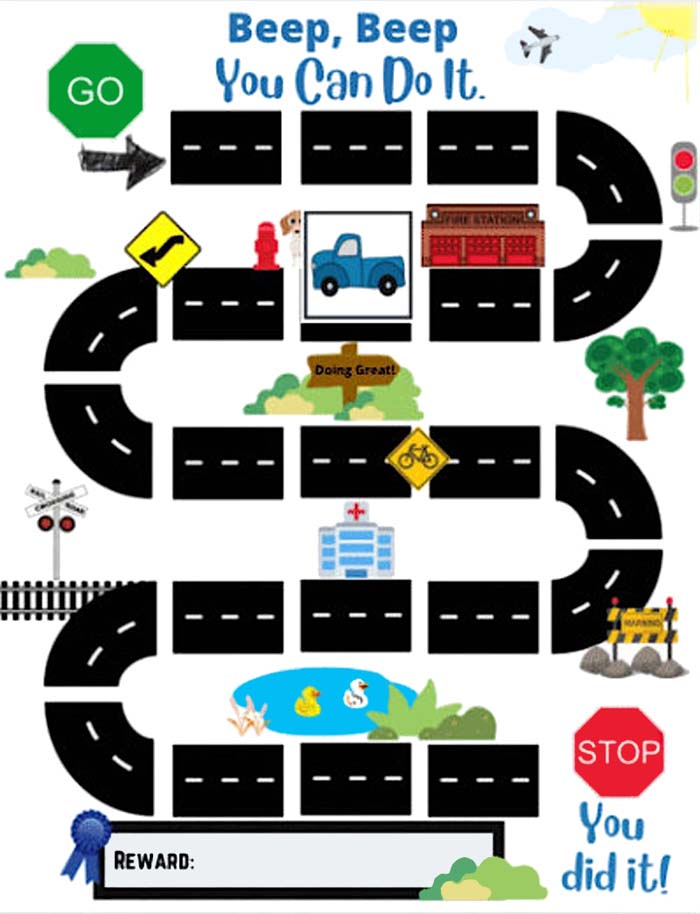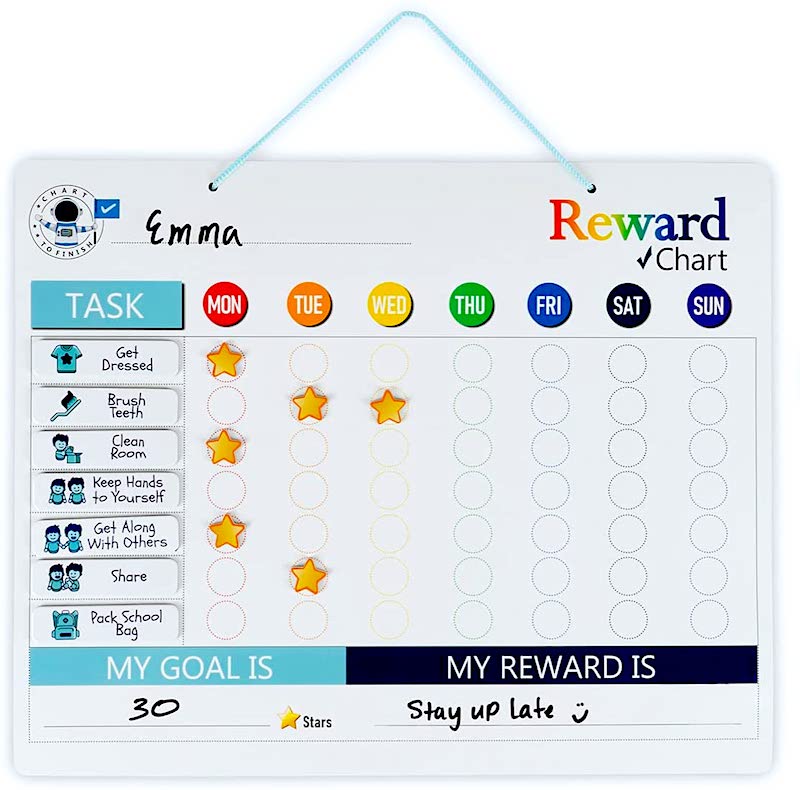Are you looking for an alternative to behavior charts that really works? Have you tried star charts to influence your child’s behavior only to see them fail?
What is the Purpose of Behavior Charts?
The star chart – the magic behavior reward system we tape to a door with the best intentions of rewarding our children for good behavior and modifying behavior for the better.
We’ve seen them, we know they are recommended. We’ve been told by teachers and psychologists that they work.
But why do I have a whole host of charts with scattered stars and a kid who still consumes ½ his calories through booger eating?
The star chart takes many different forms, some don’t even involve stars, but all of them have the same basic premise: rewarding good behavior incrementally until the behavior is successfully changed.
Child psychologists will unequivocally say that positive reinforcement works much better and faster than punishment to change behavior. The American Academy of Pediatrics recommends using a rewards chart for kids. They note that gradually children will internalize their behavior, and then the chart can be phased out.
Table of Contents
- What is the Purpose of Behavior Charts?
- Why Star and Behavior Charts Don’t Work
- 6 Parts of Successful Reward Systems
- 2 Practical Analog Behavior Charts
- 7 Popular Digital Chore Charts
- Why We Created My First Nest Egg App
- How Older Kids Earn Allowance
- Conclusion about Behavior Charts and Star Charts
Why Star and Behavior Charts Don’t Work
But being a parent is a messy business, and the best-laid plans (or charts as it were) often go off the rails. Why don’t star charts work? Because we are parents and not astrologers and we are inconsistent.
We forget.
We’re traveling and the behavior chart didn’t make it into the suitcase.
We are in bed when Suzy reminds us that she played her piano.
The reward was a trip to the ice cream parlor, but it was a busy weekend.
There are hundreds of reasons parents fail at the star chart system, and most of them are as inevitable as they are demoralizing. That little chart, staring up at us, is incomplete. The neat rows of stickers just stopped when the family went on a road trip, and everyone forgot to start it back up again. Truly, the last thing parents need is one more thing to make us feel like we have failed.
The concept of a rewards chart that hangs on a wall works in very limited circumstances. Teachers frequently use them in classrooms, which is exactly where they belong. It’s a room full of captive audience members, all guaranteed to be in the same place at the same time every day, who are very interested in adding stickers to their charts just like all of their friends.
At home, you have kids running in 17 different directions, siblings who frequently don’t care how the other kids are doing, and parents who are just trying to keep their heads above water.
So how do we balance these challenges with a system which can clearly affect meaningful change in our children’s lives in the long term?.
We either dig up the superhuman resolve to consistently engage with an analog chart, or we integrate the system into the 21st century.
6 Parts of Successful Reward Systems
Whether you’re using an old-school chart or jumping into a digital one, it’s important to first review what makes charts successful in the first place. In an excellent article for Psychology Today, Amy Przeworski Ph. D, lays out what makes a rewards system successful.
First, focus on one behavior at a time – stop the booger eating!
Second, agree upon a meaningful reward with your child.
Third, select an achievable number of stars for your child to earn the reward. No toddler is going to make it through a 100 star reward chart.
Fourth, keep your child’s eye on the prize. Out of sight, out of mind. If your children can see the reward they will want it more.
Fifth, BE CONSISTENT and connect the star to the wanted behavior. This is where many such systems fail.
Sixth, BE POSITIVE!! This should be fun.
Reward Pitfalls
Star charts are not bribes. If your child is in a store and throws a tantrum, and you buy her cookies to stop the tantrum, that’s a bribe. The child knows exactly how to get the cookies in the future:
Tantrum = Reward
If you are about to go into the store and you remind your child that being on her best behavior in the store will earn her a star, that is positive reinforcement.
Good behavior = Reward.
As parents of 7 children, we have tried every rewards system imaginable for our kids. Learn from our failures, successes and innovations.
Now that you understand more about the psychology behind reward and chore charts well share some options that you can use with your family.
Want help motivating your kids to develop good habits? Download the award-winning start chart app that actually works – anywhere!
2 Practical Analog Behavior Charts
Here are 2 printable (analog) behavior charts that you could try with your family.
1. Behavior / Reward Chart for Children
See this printable Behavior Chart Reward Chart on Etsy.
“Snap! The job’s a game!” Mary Poppins was right about most things – a spoonful of sugar makes cough syrup taste better, childhood slips like sand through a sieve, and jobs are more fun when they’re games. When we have had success with rewards charts with our children, it has been because they didn’t know it was a rewards chart. This is an adorable, inexpensive printout from Etsy, ideal for little kids. It is cute, positive, and fun. If you put this up on your child’s door so they could see it every time they went into or out of their room, your child would be motivated to move along the board.
2. Chart to Finish Behavior Chart and Chore Chart for Kids
See this Reward Chart on Amazon
This is the classic star chart and includes everything you need to get started. We like this one because it gives a clear goal (though the 30 in the picture is very high for little kids), and has a spot for the reward. It has spaces where you can write each task and comes with cute little star magnets. This board is bright and colorful and lets the kids put together their goal with a variety of tasks.
If you go analog, here are a few tips:
First, make it easy! Your goal is to get your child to achieve and enjoy it.
You don’t want to let them cheat, but you also don’t want to make it so difficult as to be unattainable. You want your child moving along this board as quickly as possible. Every move represents an accomplishment and the pride of achievement.
Second, choose an appropriate prize. Work with your child to choose something in an appropriate price range and talk to your child about how much the object is worth and the effort they will be putting forth to obtain it. T
his will get them thinking about equating effort with achievement and value.
Third, DO NOT QUIT. As discussed above, lack of consistency is where most such games and charts fail. Teaching children is not always easy. It can be exhausting. Most of us have spent hours helping our children build good habits – pleases and thank yous, eating with utensils, and eating vegetables. They take time and patience.
This will be no different, but the end result is worth the effort.
Finally, focus on one behavior at a time. Kids get overwhelmed by the overall idea of getting better at everything. It seems unattainable. However, one week of making their bed every single day?
That seems achievable. If they succeed, they will equate the good behavior with a good feeling, which will make them want to continue it long after the chore chart has been forgotten. That’s a win.
7 Popular Digital Chore Charts
There are obvious pitfalls to the analog charts which hinder their consistency. They tend to be used for a finite period of time, aren’t generally portable, and tend to get boring after a while.
Fortunately, there are several online App options that offer digital chore charts.
If you search for a chore chart in the App Store you will be overwhelmed by the choices.
There are debit card-based apps such as Greenlight and GoHenry, which track chores and allowance. These are primarily banking apps and are more appropriate for older kids who have outgrown chore charts.
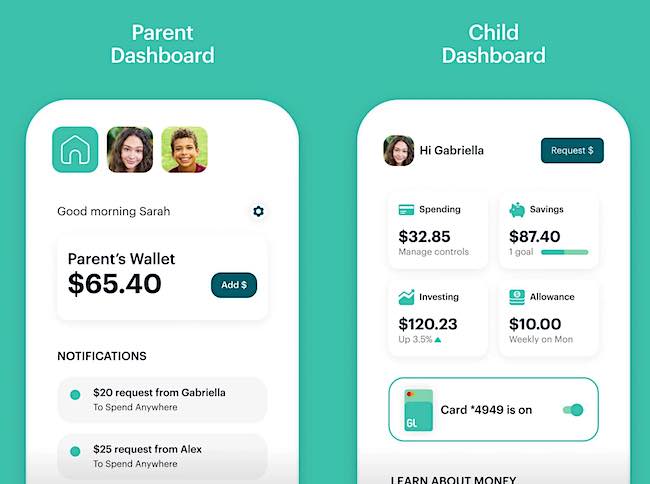
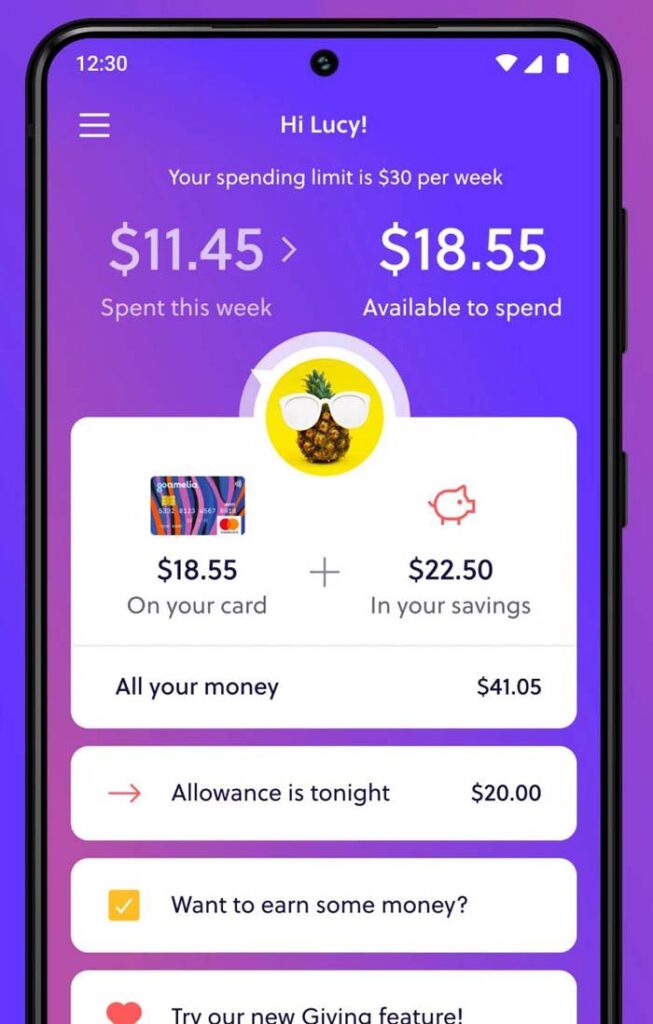
There are slews of chore charts where you can assign chores to your kids including Chorsee, KKidd, Instigo, Homey and S’mores Up.
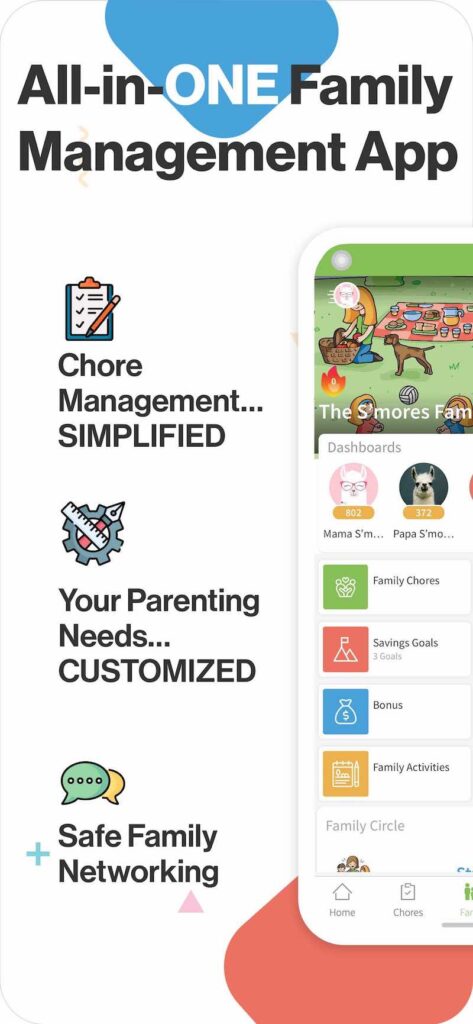
These apps vary in price, the methodology in how you can assign and complete tasks, and the rewards systems they implement.
So, if there are so many Chore Apps, you might be asking why we created our own.
Why We Created My First Nest Egg App
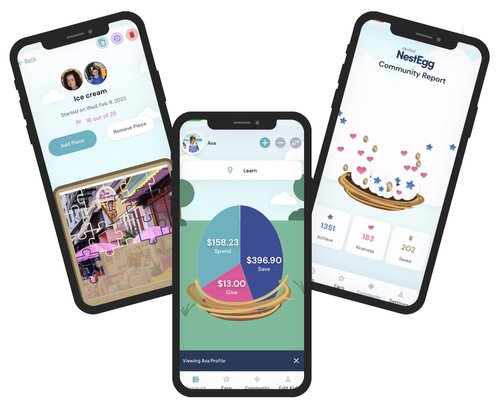
We struggled to get our little kids excited about the existing chore charts. Many are very check-list based, but our kids just don’t do well with check-lists.
Many require a time-consuming set-up, and we tend to quit halfway through. Somehow in our sleep-deprived and addled mom brains, we thought the best solution was to just make a system that actually worked for us.
A Successful Behavior Chart Reward System in an App
We interviewed moms, dads, behavioralists and psychologists to develop a behavior chart that really motivated our kids AND was easy to use.
A Behavior Chart App with Financial Impact
Meet the My First Nest Egg App. It is built with a patent-pending system to easily modify behavior and build good habits.
The app allows you and your child to:
- clearly identify the desired behaviors (challenges)
- set the number of times the behavior needs to happen
- pick a prize (you can upload a picture or screenshot)
The app then breaks the picture into a puzzle.
piece – an image of a doll screenshot
How the Behavior Reward Chart Works
Anytime your child completes the behavior, they are rewarded with a new puzzle piece. Your child can watch their prize come together piece by piece.
There is a view-only mode so your child can request puzzle pieces and gauge progress on the way to their goal.
They can see what challenges they have to complete in order to earn the next piece and view the reasons they have earned pieces in the past.
Your Child Will be Motivated!
Your child will absolutely love earning pieces and watching them fly into place. You will be giving them the instant gratification of a puzzle piece while teaching them the grit and delayed gratification it takes to earn and achieve a longer-term goal.
The Value of Behavior Rewards
One important theme often lost in the behavior conversation is self-esteem. It’s understandable. We’re busy, often overwhelmed, perpetually tired, and chronically underappreciated parents. We just want to avoid stepping on legos on our way to clean up the glass of milk currently seeping into the carpet. But self-esteem is important.
Achievement and Depression are inversely related.
Dr. Jennifer Gatt, Ph.D. Child Psychologist, and Advising Board Member, My First Nest Egg
Building our Kids Self Esteem
Kids need to achieve to feel good about themselves. When they feel good about themselves they feel like they can achieve.
It is the best kind of circular behavioral reinforcement.
The issue with little kids is balancing out the need for praise and rewards with the pitfalls of spoiling them. Potty training is a great example.
Potty Training with My First Nest Egg App
The best way to potty train is to get that kid on the little portable potty one million times a day. They are so proud of themselves when they make it, and that’s one less mess or diaper for you. But it’s impractical to give your child a treat every single time. We hadn’t even thought of this use for our system until a user told us that the puzzles made potty training a breeze.
She built a puzzle. The only task was going potty. The picture she used was of a treat.
Every time her child used the potty she gave him a puzzle piece. He was proud and felt rewarded, and she avoided the repetitive sugar high. When he completed his puzzle she gave him the treat. It was a win/win.
Other Behaviors That Can Earn Rewards
This rewards system can be applied to everything from making the bed to days without nail-biting. The pieces provide instant gratification and reinforcement, but the prize gives them a goal and teaches delayed gratification.
Their siblings and peers see the rewards, small and large, being given consistently, and the achievement is infectious. A parent’s engagement with the App typically lasts 30 seconds so it’s not taking up precious time.
How Older Kids Earn Allowance
My First Nest Egg also works as an allowance system for slightly older children. You can identify how much you want to pay your child for a desired set of chores.
For example, completing twenty chores might equal five dollars.
Every completed chore earns a puzzle piece, and when the puzzle is completed five dollars is automatically transferred into your child’s “spend” account.
This type of allowance system fosters accountability and allows your child to visualize their hard work incrementally earning them money.
By infusing a little tech into an analog system, My First Nest Egg gives you a powerful tool to help your child build the good habits they will eventually internalize to become successful adults.
RELATED ARTICLE: Chores and Allowance List By Age
The Value of Earning an Allowance
Allowance can be a polarizing word. Some parents love it, some hate it.
We hesitated to use it.
The word is typically associated with a regular payment to a child – weekly or monthly. The problem is that if the allowance isn’t tied to the effort, children can learn negative life lessons (something for nothing).
We built our system to be a fun and playful way to show that each task incrementally works into their allowance. They can earn it as quickly as slowly as they want.
It’s like a gig economy for small people. Earning, saving, spending and giving responsibly are the hallmarks of successful people.
Allowing your child to do all of these things as early as possible builds the same good habits that will translate into them routinely putting 20 to 30% of their earnings into a retirement fund.
Money habits are set by age 7, so the earlier you start the more ingrained those good habits will be. Imagine a 10-year-old who can set a goal for a new bike, budget a part of their allowance towards that goal (the App lets you do this automatically), and feel the pride of accomplishment when they can ride that bike down the street! They know the work that went into earning it. They know that they did the work and earned that bike. They will keep reaching higher, bigger and more expensive goals. That kid is going places.
Conclusion about Behavior Charts and Star Charts
The bottom line is that childhood is our one shot to instill the values and discipline into children that they will need to be successful in life.
That is as overwhelming as it is true.
We talk to countless adults who tell us that they wish they had learned lessons around goal-setting and financial literacy as children. They lament that it’s a rough lesson to learn when you’re 30 and in debt.
However when you start to teach these lessons to kids, just start. There will always be trial and error, wins and losses, successes and failures.
But your perseverance through those will teach your kids valuable lessons about staying the course through adversity.
We tried very hard to make these lessons more fun and habits easier to build, but all good things take effort.
The more you put in, the more you get out. That’s Life Lesson #1.

